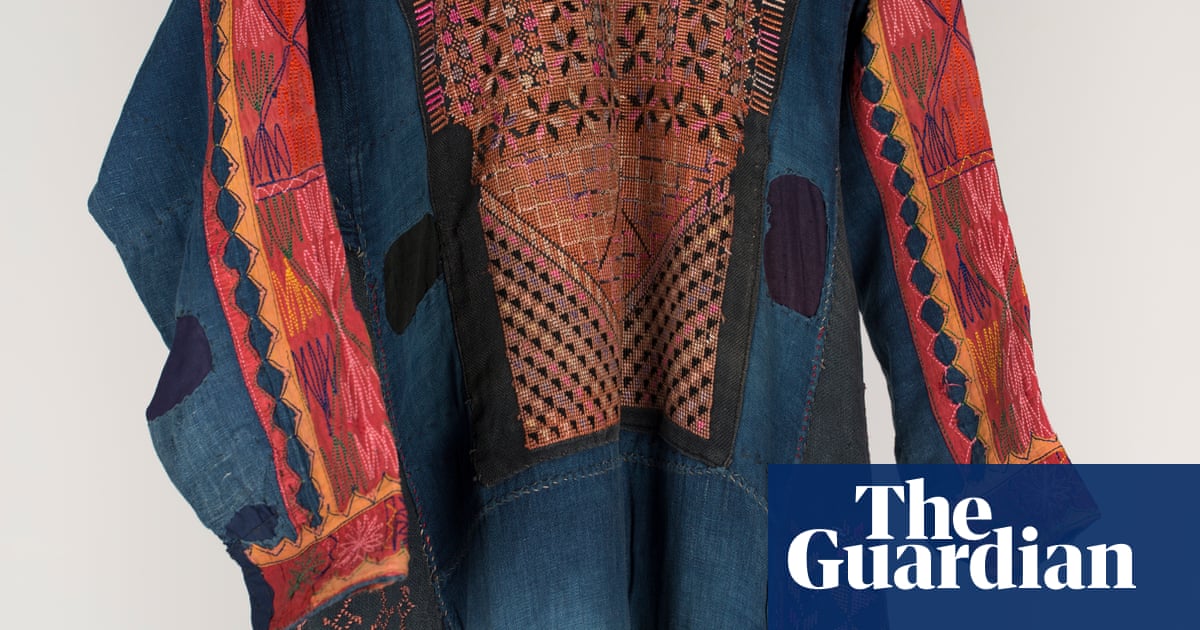
With its faded fabric and darned-up holes, the first Palestinian dress on display at Kettle’s Yard in Cambridge might initially seem unremarkable. Unlike the opulent thobes elsewhere in the gallery, it’s a thoroughly worn garment created for everyday wear. But it’s also a fascinating window into the life of a rural woman from the Gaza region in the 1930s: the knee patches replace fabric worn away from field and domestic work, while the gaps by the chest panel show alterations made for breastfeeding. The embroidered patterns are likely samples from past dresses or hand-me-downs from relatives. As with all of the embroidered clothes and items currently on view, it’s an expression of class, gender and sociopolitical change.
“Embroidery is a practice that in itself feels so humble: the repetitive binding of thread to fabric,” says curator Rachel Dedman. “And yet, when you start to look at the garments, the people who make them, you start to understand the big picture events in history.”
Boasting more than 40 items across three rooms, Material Power is the first major exhibition of Palestinian embroidery in the UK for over three decades. Some of the dresses, on loan from collections in Jordan and the West Bank, are on show here for the first time. Through up-close displays, archive photographs and video footage of textile workers in action, visitors can trace the history of what is now one of the region’s most prominent cultural outputs, from early village tradition to formidable tool of resistance.
Drawing on Dedman’s expertise as curator of contemporary art from the Middle East at the V&A, the story is told in rich detail, with attention paid to regional variations in technique and motifs. As colonialism and changing technologies take hold, styles begin to change, as seen in the dress alterations and new hybrid patterns; a process that continues towards more recent national conflicts.
In the second room, the embroidery becomes more overtly political. During the first intifada in the late 1980s, women would stitch symbols of resistance on to their clothes for protests; a striking collection of dresses bearing the then-forbidden Palestinian flag and colours line the back wall. “When we make something to take to protests now, it’s characterised by speed – scrawling a sign or printing something out. But these would’ve taken years to make, in really difficult circumstances,” Dedman says, explaining how women might have teamed up to buy different colours of thread so as to not draw attention to themselves, before stitching secretly at night. “There’s something about the longevity of the making of it that reflects the nature of the struggle.”
Much like some of the historical dresses, which have been reworked for new generations and changing standards and tastes, the exhibition is a living history, encouraging renewed reinterpretations of the craft. Exhibited alongside the garments are contemporary embroidery works by artists from the Levantine region and its diaspora, like Mona Hatoum’s delicate lattices of human hair and Majd Abdel Hamid’s abstract cross-stitch series, which uses white thread on white canvas to confront and “reactivate” the practice.
Abdel Hamid began the project in 2015 and plans to continue until his hands cease to function. “It’s a repetitive gesture that allows you the space to think,” he says, pointing to the increased popularity of the craft on a global scale during the Covid lockdowns. “Embroidery can be a way of dealing with a lot of traumas.” Stitching also forges room for him to connect with his Palestinian heritage after years of displacement. “It’s a very subtle way of feeling home.”
Meanwhile, Lebanese-British artist Aya Haidar reimagines her family history through vibrant threads and chintzy fabric on embroidery hoops. Inspired by the stories her mother and grandmother would share as they taught her to stitch, the series pieces together their first-hand experiences of surviving through Lebanon’s civil war. In one piece, family members wear pots and pans as makeshift helmets in the living room; another hoop depicts them seeking shelter under a bed frame in case the ceiling falls down. Rendered in wobbly stitching and colourful thread, the scenes are surprisingly soft and intimate. “Yes, I talk about big topics like conflict and migration, but really it’s about pinpointing those smaller stories that humanise a situation,” she says.
While she made the hoops, Haidar followed in her ancestors’ footsteps and shared her family stories and embroidery skills with her own children. “Talking about their histories while they stitched was the way in which stories were passed down,” she explains. “Craft gave women a voice before society ever did.”
As much as the history of Levantine embroidery is one of female resistance and labour, the exhibition includes embroidered objects made by men held as political detainees in Israeli prisons, who use the medium to express both national pride and affection for their family members. A tender collection of stationery and everyday items customised by Karam Al-Maloukh while imprisoned draws on the Palestinian colours and features the hand-stitched initials of himself and his wife. Made between 2005 and 2008, they capture the show’s overarching message: that embroidery can be much more than a simple, domestic hobby.
“There’s something universal and familiar about textiles,” says Dedman. “But in this particular part of the world, they have this meaning that goes beyond what you might expect from a craft or something handmade.”
Material Power: Palestinian Embroidery is at Kettle’s Yard, Cambridge, until 29 October












